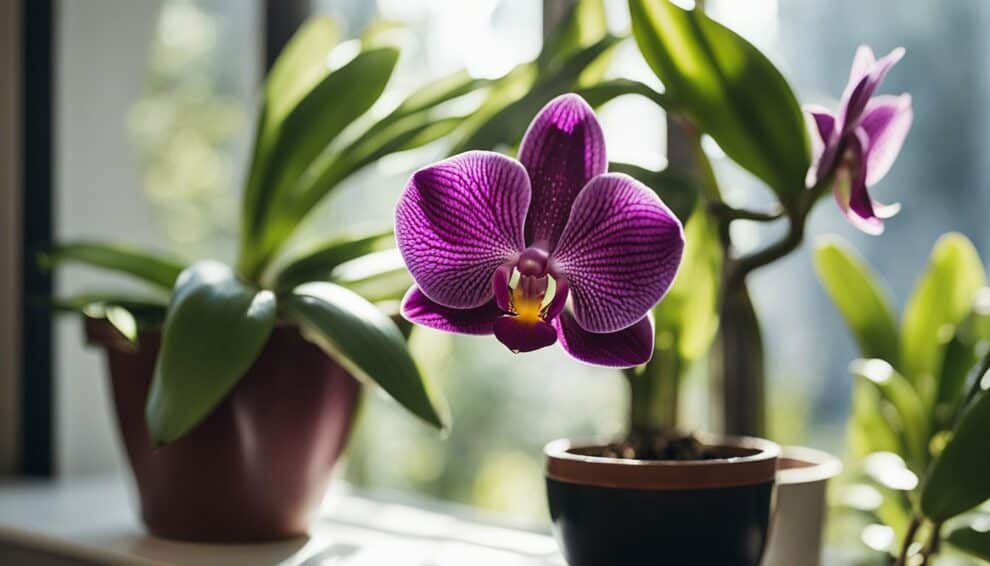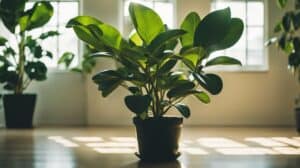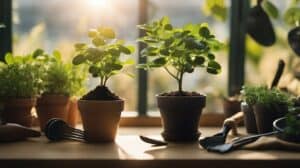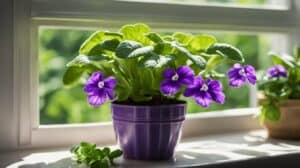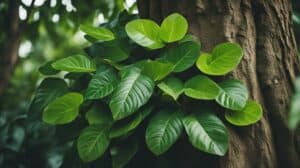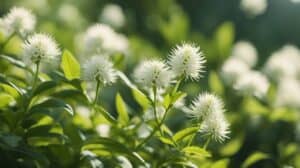Jewel orchids, also known as Ludisia discolor, are a popular choice among indoor plant enthusiasts for their striking foliage and easy care.
These orchids are native to Southeast Asia and are prized for their velvety, dark green leaves with maroon undersides.
Unlike other orchids, jewel orchids are grown for their foliage rather than their flowers.

For first-time growers, caring for a jewel orchid may seem daunting, but it’s actually quite simple.
These plants are low-maintenance and can thrive in a variety of lighting conditions.
They prefer bright, indirect light and should be watered when the top inch of soil feels dry to the touch.
Overwatering can lead to root rot, so it’s important to let the soil dry out between waterings.
In this article, we will delve into the basics of jewel orchid care for first-time growers.
From lighting and watering to fertilizing and propagation, we will provide all the information you need to successfully grow and care for these beautiful plants.
Whether you’re a seasoned plant parent or a beginner, this guide will help you become a confident and successful jewel orchid grower.
Getting to Know Ludisia Discolor
Origin and Characteristics
Ludisia discolor, commonly known as Jewel Orchid, is a terrestrial orchid species native to Southeast Asia.
It is a popular ornamental plant among gardeners and orchid enthusiasts due to its attractive foliage.
The plant gets its name from the unique coloration of its leaves, which resemble jewels.
Jewel Orchids are relatively small plants, growing up to 12 inches tall.
They have glossy, dark green leaves with striking silver veins that run throughout the leaf.
The leaves are broad and oval-shaped, and the plant produces small white flowers that bloom in the fall.
Why Choose Jewel Orchids
Jewel Orchids are an excellent choice for first-time growers due to their ease of care.
They thrive in low to medium light conditions and prefer well-draining soil.
These orchids are also relatively low maintenance and do not require frequent watering.
Another reason to choose Jewel Orchids is their unique appearance.
The striking silver veins on the leaves make them stand out from other plants, adding a touch of elegance to any room.
Additionally, the plant’s small size makes it ideal for growing in small spaces or as a tabletop decoration.
Overall, Ludisia discolor is an excellent choice for those looking to add a touch of elegance to their home or garden.
With proper care, this plant can thrive and provide years of enjoyment.
Essentials of Jewel Orchid Care

Lighting Requirements
Jewel orchids prefer bright but indirect light. Direct sunlight can scorch the leaves and cause damage.
A north-facing window is an ideal location for these plants.
If you don’t have a north-facing window, you can use a sheer curtain or blinds to filter the light.
If your plant isn’t getting enough light, you may notice that the leaves are losing their luster and the plant is growing slowly.
Watering Techniques
Jewel orchids prefer to be kept evenly moist, but not waterlogged. Overwatering can lead to root rot and other issues.
It’s best to water the plant when the top inch of soil feels dry to the touch.
When watering, make sure to water thoroughly and allow excess water to drain away.
It’s also a good idea to use room-temperature water, as cold water can shock the roots.
Ideal Temperature and Humidity
Jewel orchids prefer temperatures between 60-80°F (15-27°C). They also prefer high humidity levels, around 50-70%.
If the air in your home is dry, you can use a humidifier or place a tray of water near the plant to increase humidity.
Avoid placing the plant near drafty areas or heating/cooling vents, as this can cause stress to the plant.
Overall, jewel orchids are relatively easy to care for and make great houseplants for beginners.
By following these simple guidelines, you can enjoy a healthy and thriving jewel orchid in your home.
Propagation and Repotting

Propagating Ludisia Discolor
Propagating Ludisia discolor is relatively easy. The plant can be propagated through division or through stem cuttings.
Division is the easiest way to propagate the plant. When dividing the plant, ensure that each division has at least one healthy stem and a good root system.
The best time to divide the plant is during the spring when the plant is actively growing.
To propagate Ludisia discolor through stem cuttings, select a healthy stem that is at least 3 inches long.
Cut the stem just below a node and remove the lower leaves. Dip the cut end in rooting hormone and plant it in a pot filled with moist potting soil.
Keep the soil moist and place the pot in a warm, bright location. The cutting should root within a few weeks.
When and How to Repot
Ludisia discolor should be repotted every two years or when the plant has outgrown its current pot.
The best time to repot the plant is during the spring when the plant is actively growing.
When repotting, use a pot that is slightly larger than the current pot and has good drainage.
To repot, gently remove the plant from its current pot and remove any dead or damaged roots.
Add fresh potting soil to the new pot and place the plant in the center of the pot. Fill the pot with soil, making sure to cover the roots.
Water the plant thoroughly and place it in a warm, bright location. Avoid fertilizing the plant for at least two weeks after repotting to prevent root burn.
By following these simple steps, first-time growers can propagate and repot Ludisia discolor successfully.
Troubleshooting Common Issues

Pest Prevention and Control
One of the most common issues with growing Ludisia discolor is pest infestation. These orchids are susceptible to spider mites, mealybugs, and scale insects.
To prevent pests from infesting your plant, it is important to keep the growing area clean and free of debris.
Inspect the plant regularly for signs of infestation, such as yellowing leaves, webbing, or sticky residue.
If you do find pests, remove them immediately using a gentle insecticidal soap or neem oil. Repeat the treatment every few days until the pests are gone.
Addressing Yellowing Leaves
Yellowing leaves can be a sign of several issues with Ludisia discolor, including overwatering, underwatering, nutrient deficiency, or pest infestation.
To determine the cause, inspect the plant and check the soil moisture level.
If the soil is dry, water the plant thoroughly and ensure that excess water drains away.
If the soil is wet, reduce watering and allow the soil to dry out before watering again.
If the plant is not receiving enough nutrients, fertilize it with a balanced orchid fertilizer. If pests are the cause, treat the plant as described above.
Root Rot and How to Avoid It
Root rot is a common issue with Ludisia discolor, and it is often caused by overwatering or poor drainage.
To avoid root rot, ensure that the pot has adequate drainage holes and that excess water drains away quickly.
Water the plant only when the soil is dry, and do not allow the plant to sit in standing water.
If you suspect root rot, inspect the roots for signs of decay, such as brown or black, mushy roots.
If you find root rot, remove the affected roots and repot the plant in fresh, well-draining soil.
Frequently Asked Questions

What type of potting mix is ideal for growing Ludisia discolor?
Ludisia discolor thrives in a well-draining, nutrient-rich potting mix. A mixture of peat moss, perlite, and orchid bark is ideal for these plants.
The potting mix should be kept moist but not waterlogged, as these plants prefer slightly moist soil.
Can you provide tips on propagating jewel orchids successfully?
Propagation of Ludisia discolor can be done through stem cuttings or division of the plant.
Stem cuttings should be taken from healthy, mature stems and placed in a moist potting mix.
Division should be done during repotting, separating the plant into smaller sections with roots attached.
Both methods require consistent moisture and warmth to encourage root growth.
Is it necessary to create a terrarium environment for jewel orchids?
While Ludisia discolor thrives in humid environments, it is not necessary to create a terrarium environment for these plants.
They can be grown in regular pots with proper drainage and kept in a humid room or with a humidifier nearby.
Where can I find jewel orchids for purchase?
Jewel orchids can be found at most garden centers, nurseries, and online plant shops.
It is important to purchase plants from reputable sources to ensure quality and health.
How often do jewel orchids bloom, and what triggers their flowering?
Jewel orchids typically bloom once a year during the fall or winter months.
Flowering is triggered by a combination of cooler temperatures and shorter daylight hours. Consistent care and proper nutrition can also encourage blooming.
What kind of fertilizer should be used for jewel orchids, and how frequently?
A balanced fertilizer with equal parts nitrogen, phosphorus, and potassium is ideal for Ludisia discolor.
Fertilizer should be applied every two weeks during the growing season and reduced or stopped during the dormant season.
Over-fertilization can lead to root burn and damage to the plant.






